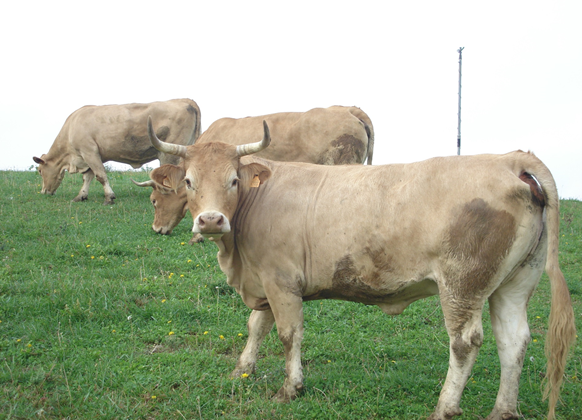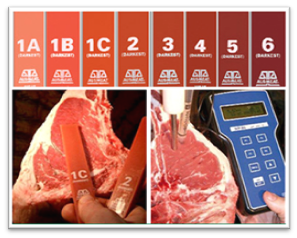The crisis that arose with bovine spongiform encephalopathy led to the development of efficient traceability systems which monitor animals from birth to point of sale of their meat. The information recorded is abundant and low-cost, thus it can be easily included as phenotypic traits for animal breeding purposes. In Spain, the traceability database is called Sistema Integral de Trazabilidad Animal (SITRAN).
Pirenaica is a local breed cattle, abundant in the Spanish Pyrenees. Some farmers rearing them are within one of the two Protected Geographical Indications (PGIs): Ternera de Navarra and Euskal Okela, which has allowed access to individualised extra data related to meat quality (meat colour and pH) that have been crossed with the data collected in the breed’s genealogical book.
Confederación de Asociaciones de Ganado Vacuno Pirenaico (CONASPI) is the farmers’ federation for the Pirenaica breed. Its objective is the genetic improvement of the breed, which was initially based on data collected at the farm level (yield control). In 2020, the data come from 260 farms and 8,290 animals, in which birth weight and weight at 90 and 210 days was collected. Since 2007, data on carcass weight, conformation, fatness, meat colour, and meat pH have been also gathered directly from SITRAN databases with the corresponding permission and collaboration of the PGIs. With this information, the Animal Genetics team of the University of Zaragoza applies the BLUP and provides CONASPI with the Selection Indices that are used when choosing improving dames and sires for characteristics related to carcass quality and others. Meat colour is evaluated at the slaughterhouse, in one-year-old animals with a visual standard, and will soon be available as a trait for selection; pH, on the other hand, measured at 24 h post-slaughter, needs further improvements.
 |  |
The greatest expected benefit of this innovation is that the farmer works with more productive animals which are more homogeneous in carcass characteristics, making their farm much more competitive on the market. It should be considered that specific carcass and meat quality requirements are set to meet some quality brand specifications, so farmers might receive some financial rewards as well if they consider the genetic improvement for carcass and meat quality in their herd.
The genetic improvement scheme of the Pyrenean breed began in the 1970s and its control was derived from the genetic team of the University of Zaragoza. The effort and field work of the CONASPI technicians has resulted in it currently being a very robust scheme with a large amount of data feeding it. At the beginning of the century, researchers began working with characteristics related to carcass and meat quality (many of them have a subjective component of the technician scoring them). When acceptable correlations were established, carcass quality began to be incorporated into the genetic improvement scheme in 2010. Meat colour is expected to be available next year, but further improvements are needed for meat pH.
As it is a programme of genetic improvement that has been well established over time, not all of the changes that have been introduced have involved extra effort. It is important to value the perseverance of all the actors involved (farmers, technicians, governmental administration, and researchers).
Source of information:
- Interview with CONASPI by the BovINE Network Manager from Spain (Paola Eguinoa: peguinoa@intiasa.es)
- Interview with Luis Varona, researcher from Unizar
- CONASPI Anuario 2019. http://www.conaspi.es/verdocumento.asp?iddoc=7616
- Altarriba et al., 2009. Exploring the possibilities of genetic improvement from traceability data An example in the Pirenaica beef cattle. Livestock Science 125: 115-120
- Varona et al. 2009. A model with heterogeneous thresholds for subjective traits: Fat cover and conformation score in the Pirenaica beef cattle. Journal of Animal Science 87: 1210-1217
- Altarriba et al. 2005. Consequences of selection for growth on carcass and meat quality in Pirenaica cattle. Livestock Production Science 95: 103-114.
Further information:
- Website of CONASPI: http://www.conaspi.net/
- Website of ASPINA: http://conaspi.net/vercontenido.asp?conid=13489&menid=1530&web=22